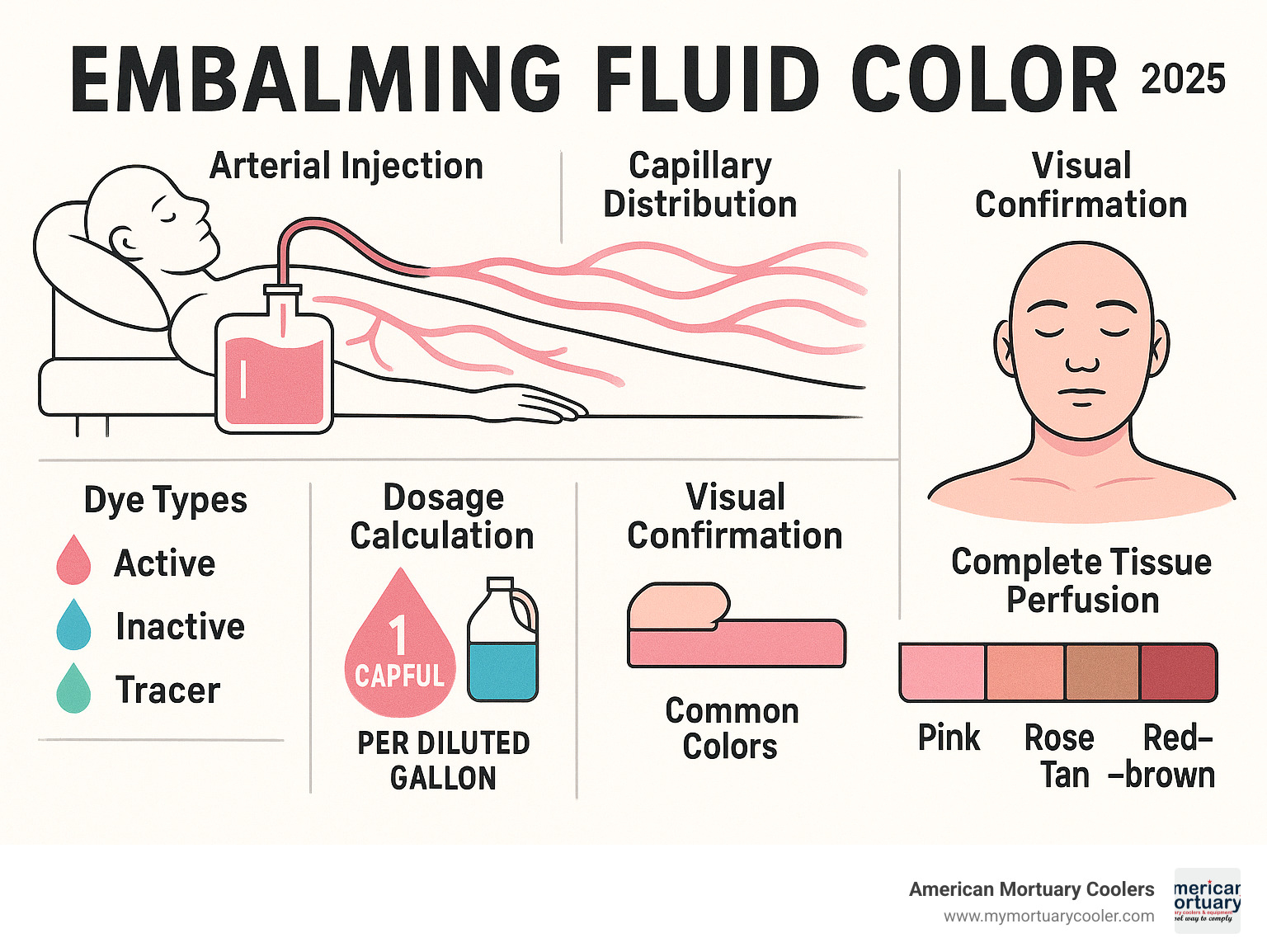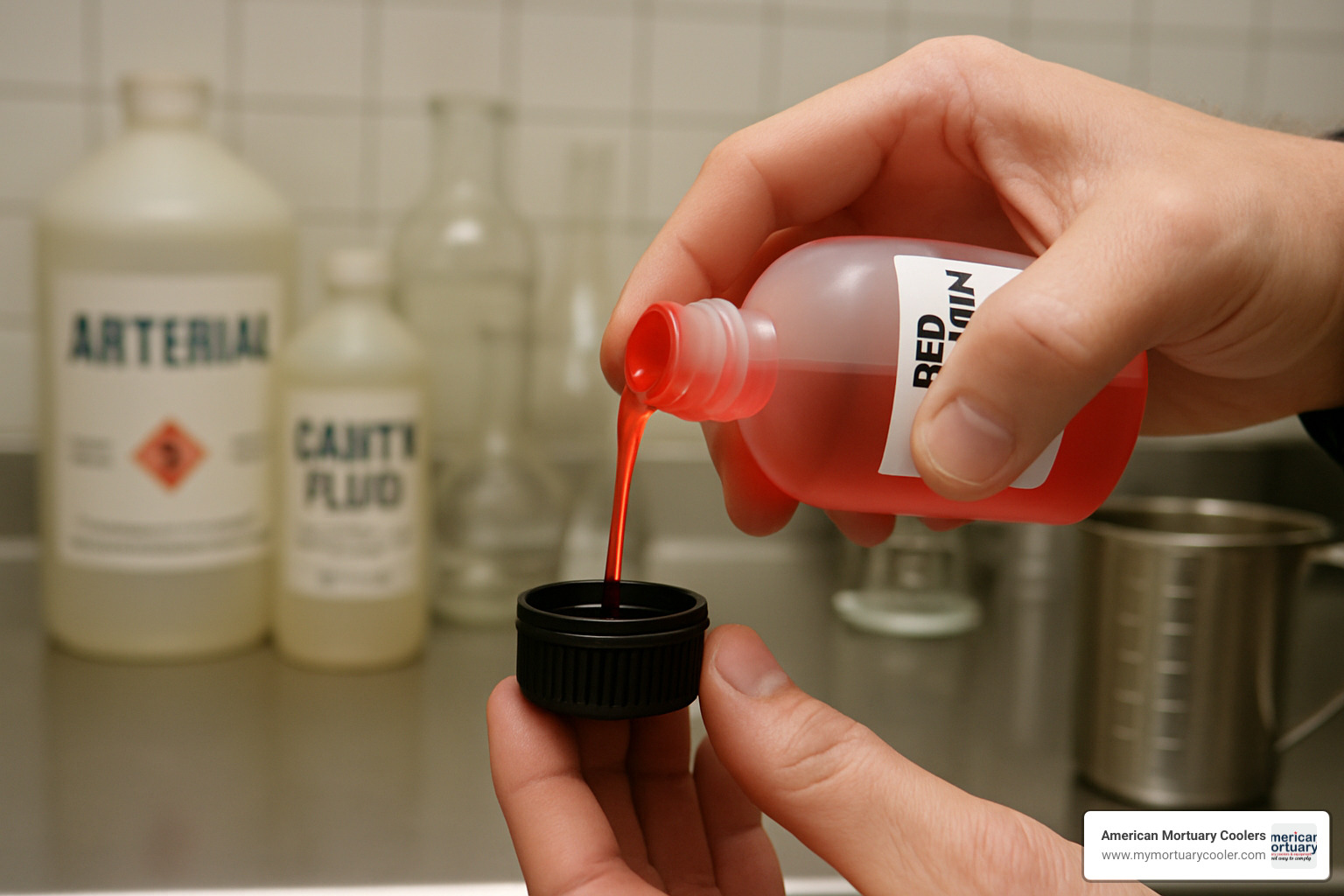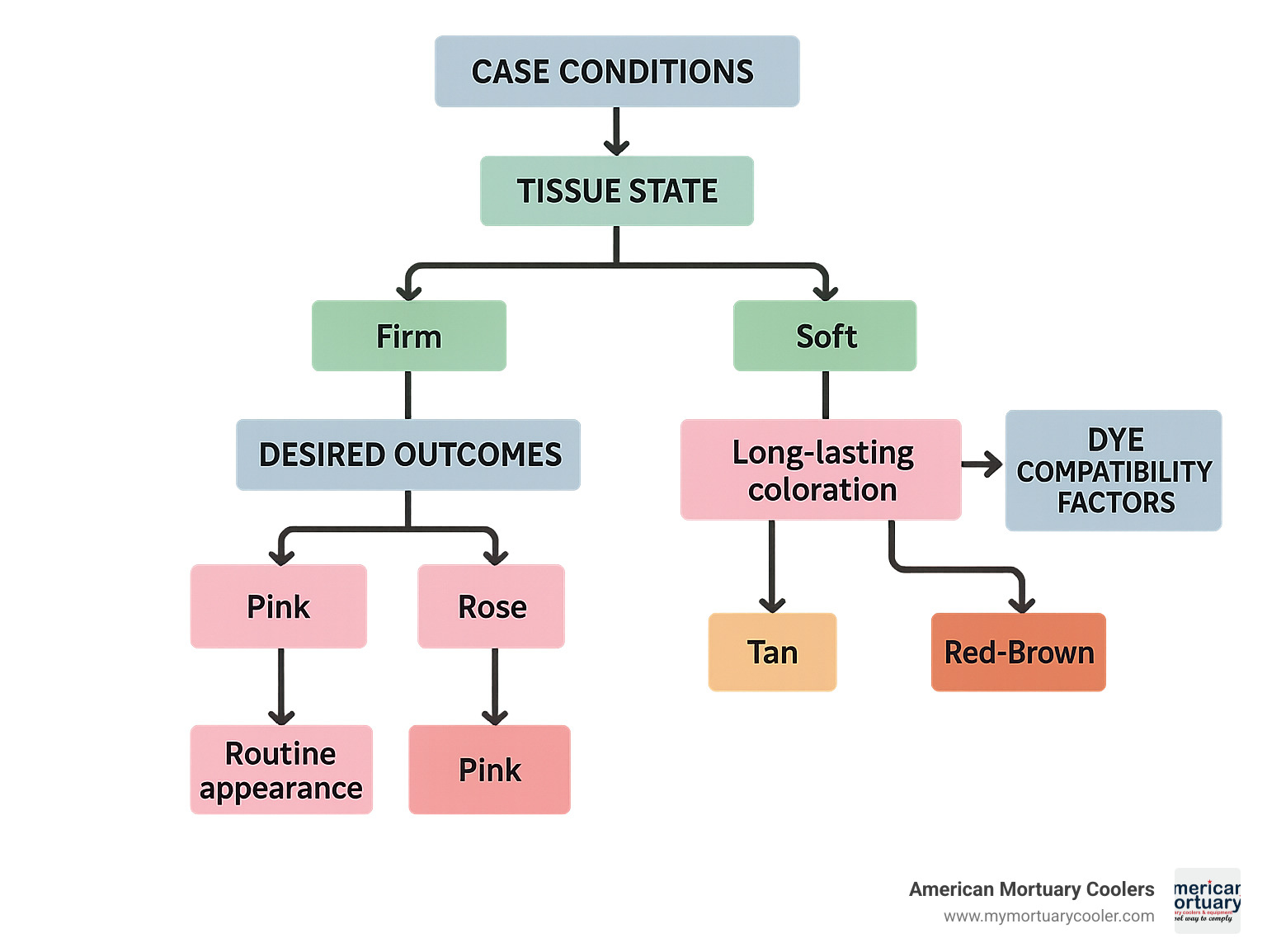Why Embalming Fluid Color is Essential for Professional Results
Embalming fluid color serves three critical purposes in mortuary science: confirming proper fluid distribution throughout the body, restoring natural skin tones for viewing, and providing visual feedback to embalmers during the injection process.
Quick Reference: Embalming Fluid Color Basics
- Active dyes: Stain tissue permanently and restore natural coloration
- Inactive dyes: Only color the fluid in the bottle for identification
- Tracer dyes: Show fluid distribution patterns during injection
- Common colors: Pink, rose, tan, and red-brown for natural appearance
- Dosage: Start with 1 capful per diluted gallon, adjust as needed
- Duration: Color remains in tissue over time when using active dyes
The choice between colored and uncolored embalming fluids isn't just about aesthetics. As one embalming professional noted: "Have you ever embalmed a jaundice case and it looked to be a good pink tone when you finished, but when you returned the next day the jaundice coloration had returned?" This common scenario highlights why proper dye selection and application techniques are crucial for lasting results.
Active dyes actually penetrate and stain the tissue, helping mask discolorations like jaundice while providing that natural, lifelike appearance families expect. Inactive dyes simply tint the fluid for identification purposes. Understanding this difference can make or break your embalming results.
In the United States, funeral homes use approximately 20 million liters of embalming fluid annually. With formaldehyde content ranging from 5-37% and methanol from 9-56%, these chemicals require careful handling and precise color matching for optimal outcomes.
I'm Mortuary Cooler, and I've spent years helping funeral professionals understand the technical aspects of embalming fluid color selection and application. My experience with mortuary equipment has shown me how proper fluid color choice directly impacts both embalming success and family satisfaction during viewings.

Easy embalming fluid color word list:
What You'll Learn
Throughout this comprehensive guide, we'll answer the most pressing questions about embalming fluid color that professionals encounter daily. You'll find practical tips for selecting the right dye for different conditions, learn proper dosage calculations, and understand how to troubleshoot common color-related challenges.
We'll also bust some persistent myths in the industry - like the belief that all dyes work the same way or that more color always means better results. By the end of this article, you'll have the knowledge to make informed decisions about dye selection and application that will improve your embalming outcomes and family satisfaction.
Why Color Matters in Embalming
Think of embalming fluid color as your silent partner in the preparation room. Every time you inject colored arterial fluid, you're getting instant visual confirmation that your fluid is actually reaching where it needs to go. Without this visual feedback, you might miss those tricky areas where circulation was poor or where arterial blockages are hiding.
But here's what really matters - the psychological comfort this brings to grieving families. When tissue looks natural and peaceful, it helps families process their loss in a healthier way. We're not trying to make someone look alive again. We're helping them look dignified and at peace, the way their loved ones want to remember them.
Embalming fluid color becomes your best friend when dealing with challenging cases. That jaundice case that's been keeping you up at night? The right dye can help restore natural skin tones and mask those yellow-green discolorations. Same goes for cases involving prolonged illness or certain medications that leave unusual skin tones behind.
For those training new embalmers, colored fluids are worth their weight in gold. The visual feedback helps apprentices understand how fluid moves through the body and develop proper injection techniques. It's like having a teaching tool built right into your process.
The firming feedback you get from colored fluids also tells you when preservation is happening effectively. You can literally see the fluid working as tissue firms and takes on that natural appearance.
The Science Behind Tissue Tinting
The chemistry behind embalming fluid color is actually pretty fascinating. When formaldehyde enters tissue, it creates cross-links between proteins through something called Schiff base formation. This same process lets dye molecules bind permanently to those tissue proteins.
Active dyes work by forming chemical bonds directly with the proteins in tissue. That's why the color doesn't wash out or fade over time like makeup would. The formaldehyde actually helps lock the dye into the tissue structure, creating lasting coloration that can reduce or eliminate the need for external cosmetics.
Research on formaldehyde's preservative action shows this happens at the molecular level. Dyes that are compatible with this process become part of the preserved tissue matrix. This explains why some dyes work better than others and why proper chemical compatibility matters so much.
Understanding this protein cross-linking process helps you make better decisions about which dyes to use and when. It's not just about picking a pretty color - it's about choosing dyes that will work with your preservation chemistry.
Embalming Fluid Color and Family Perception
Here's something interesting about good embalming fluid color work - families often don't consciously notice it. They just feel that their loved one looks "natural" or "peaceful." But poor color choices? Those get noticed immediately, and not in a good way.
When internal dye work is done properly, families frequently comment that it looks like minimal or no cosmetics were used. Many families actually prefer this natural look over heavy cosmetic application. It feels more authentic to them.
The grief psychology research backs this up. When families feel their loved one looks dignified and natural, it genuinely helps with the healing process. On the flip side, artificial or unnatural coloration can create lasting negative memories that interfere with healthy grieving.
Understanding Embalming Fluid Color

When you're standing in the prep room looking at bottles of embalming fluid color, you're actually looking at several completely different types of products. Each one works differently, and knowing which is which can make the difference between a successful case and one that leaves you scratching your head.
Think of it like this: some dyes are like permanent markers that stain everything they touch, while others are more like food coloring that just tints the liquid. The permanent marker types are your active dyes - they penetrate deep into tissue and stay there. The food coloring types are inactive dyes that only color the fluid in the bottle.
Then you have your tracer dyes, which are like highlighters for your arterial system. They show you exactly where your fluid is going, lighting up capillaries so you can see if you're getting good distribution. Some embalmers swear by these for training new staff or troubleshooting difficult cases.
Concentrated additives give you the most control. Products like Rose Colortone Dye and ESCO Pink Fluid Color typically start with just one capful per diluted gallon. From there, you can adjust up or down based on what each case needs.
On the flip side, pre-colored arterial fluids come ready to use. No measuring, no mixing - just dilute and inject. The trade-off is less flexibility in color intensity.
| Dye Type | Primary Function | Tissue Staining | Duration | Best Use Cases |
|---|---|---|---|---|
| Active Dyes | Restore natural coloration | Permanent | Long-lasting | General embalming, jaundice cases |
| Inactive Dyes | Fluid identification | None | N/A | Inventory management |
| Tracer Dyes | Show distribution | Temporary to permanent | Varies | Training, troubleshooting |
| Concentrated Additives | Customizable coloring | Permanent | Long-lasting | Special conditions, precise color matching |
Active vs Inactive Dyes
Here's where things get interesting. Active dyes are the heavy lifters of embalming fluid color. They don't just sit on the surface - they actually bind with the proteins in tissue, creating color that sticks around for the long haul.
Rose Colortone Dye is a perfect example. It's specifically designed to be "retained by tissue over time," which means the color you see during injection is pretty much what you'll see days later. This internal staining can be so effective that families often comment on how natural their loved one looks without obvious makeup.
The beauty of good active dyes is they can eliminate your cosmetic work entirely. As one manufacturer puts it: "Often times makeup is unnecessary because of the appearance it produces." That's music to any embalmer's ears, especially when you're juggling multiple cases.
Inactive dyes work completely differently. They're basically there for bottle-only tint - helping you identify different fluids in your prep room. They won't stain tissue at all, which might seem pointless until you realize how valuable they are for inventory management and preventing costly mixing mistakes.
The fading timeline for active dyes varies, but quality formulations maintain their color throughout typical viewing periods and beyond. Oil-based arterial fluids are particularly known for producing "color that does not fade," making them ideal when you need extended viewing periods.
Tracer Dyes: Ensuring Complete Distribution
Tracer dyes are like having X-ray vision for your arterial injection. These specialized embalming fluid color additives let you see exactly where your fluid is traveling, which is incredibly valuable for capillary visualization.
When you're working on a case and notice certain areas aren't showing dye coloration, that's your cue to adjust. Maybe you need to change injection sites, increase pressure, or address an arterial blockage. Without that visual feedback, you might not catch circulation problems until it's too late.
For troubleshooting blockages, tracer dyes are indispensable. They show you in real-time whether your fluid is reaching all the areas it needs to reach. This is especially helpful in trauma cases or when dealing with advanced decomposition changes.
Apprentice education benefits enormously from tracer dyes. Scientific research on embalming chemicals shows that visual learning tools significantly improve skill development. When new embalmers can actually see fluid distribution patterns, they understand injection techniques much faster.
Many modern dye formulations pull double duty. Products like Tan Fluid Color function "as a tracer dye to indicate fluid distribution" while also serving "as a staining system" for lasting tissue coloration. It's like getting two tools in one bottle.
Most Common Hues and Their Effects
When it comes to popular embalming fluid color choices, you'll find most embalmers gravitating toward pink, rose, tan, and red-brown tones. These colors work because they naturally complement human skin pigmentation across different ethnicities and ages.
Pink dyes like ESCO Pink Fluid Color offer incredible versatility. They work well for routine cases and provide excellent visual feedback during injection. The pink coloration helps counteract that grayish pallor that can develop during embalming, bringing back a more lifelike appearance.
Rose-toned dyes, particularly Rose Colortone, are prized for their natural-looking results. These formulations often produce such authentic coloration that external cosmetics become unnecessary. That saves you time and creates a more genuine appearance that families appreciate.
Tan dyes serve specific purposes, especially when you want a more neutral or earth-toned result. Tan Fluid Color is valued for its compatibility with any arterial fluid and its ability to stay in tissue over time. It's particularly useful for complexion matching in cases where pink tones might look artificial.
Red-brown hues like those in Dodge Chromatech with its exclusive Chromatan Dye provide high-intensity coloration. These are your go-to options for challenging cases involving dehydration or emaciation, where you need maximum color impact.
Non-pink "Vitahue" options are gaining popularity as embalmers recognize that not every case benefits from traditional pink tones. These alternatives help achieve more natural results while respecting cultural preferences that may favor different coloration approaches.
Choosing and Using Embalming Fluid Color in Practice

When it comes to actually using embalming fluid color in your daily practice, success starts with understanding the fundamentals. The golden rule that most professionals follow is the 1 capful per diluted gallon starting point. This isn't set in stone, though - it's your launching pad for achieving the perfect results each case demands.
Think of dye application like seasoning a dish. You can always add more, but you can't take it back once it's mixed. That's why experienced embalmers swear by the incremental adjustment approach. Start with your base dosage, test on a leg or less visible area, then adjust up or down based on what you see.
Every case tells its own story, and your embalming fluid color choices need to listen. A routine case might need just that standard capful, while a challenging jaundice case could require 4-8 oz of concentrated dye to overcome severe discoloration. The key is reading the tissue and responding accordingly.
Modern dye formulations have made compatibility much simpler than in the past. Most concentrated additives work beautifully with any arterial fluid you choose. However, some combinations really shine - oil-based fluids are particularly noted for producing colors that stay true and don't fade over time.

Dye Selection for Special Conditions
Some cases walk through your door already announcing they'll need special attention. Jaundice cases top this list, with their stubborn yellow-green discoloration that seems determined to peek through whatever you throw at it. As one seasoned professional put it: "No single chemical mixture works for every jaundice case; assessment of tissue condition guides treatment."
The secret with jaundice isn't just using more dye - it's using it strategically. Start with a careful pre-injection using water conditioners mixed with your chosen dye. This prepares the tissue and gives your main arterial injection the best chance of success. For severe cases, you might need 8-16 oz of non-concentrated dye or half that amount if you're using concentrated formulations.
Edema cases present their own puzzle. All that excess fluid in the tissues acts like a built-in dilution system, weakening your dye concentration just when you need it strongest. These cases often benefit from waterless embalming solutions and higher dye concentrations to compensate for the dilution effect.
When trauma cases come in, you might need to get creative with bleach and dye combinations. Products like Rose Colortone Dye can pull double duty, helping to bleach out localized discolorations while simultaneously providing natural coloration.
Dehydrated or emaciated cases need a gentler touch combined with restorative thinking. Dodge Chromatech works particularly well here, especially when you combine it with humectants and other restorative agents. The goal is bringing life back to tissue that's lost its natural moisture and plumpness.
For more detailed guidance on handling these challenging situations, our guide to the embalming process covers additional techniques and considerations.
Concentrated Additives vs Pre-Colored Fluids
Choosing between concentrated dye additives and pre-colored fluids is like deciding between cooking from scratch or using a meal kit. Both have their place, and the right choice depends on your specific situation and working style.
Concentrated additives give you the freedom to be an artist with your color choices. Products like Rose Colortone Dye and ESCO Pink Fluid Color put you in complete control. Need just a hint of color for a routine case? Use less. Dealing with severe discoloration? Dial it up. This flexibility makes concentrated additives particularly valuable for funeral homes that handle diverse caseloads.
Pre-colored fluids offer the gift of consistency and speed. There's no measuring, no mixing, no second-guessing your ratios. You open the container, and you know exactly what you're getting every time. For high-volume facilities where time is precious and most cases are straightforward, this predictability is golden.
From a practical standpoint, concentrated additives usually win on cost-effectiveness. You're buying pure dye that goes further and adapts to whatever you need. Pre-colored fluids cost more per case but save labor time and eliminate mixing errors.
Best-Practice Checklist for Embalmers
Getting consistent results with embalming fluid color comes down to mastering the technical details that make the difference between good and great outcomes. Your pressure settings should typically hover around 20 lbs, with pulsation rates of 3-5 oz per minute. These settings give you even distribution without the tissue damage that comes from rushing the process.
The restricted cervical technique becomes especially important when you're working with colored fluids on head injections. Raising and clamping both carotid arteries gives you the control you need to prevent over-embalming and maintain natural-looking coloration in facial tissues.
Always run flush tests with clear solutions before introducing your colored fluid. Think of this as your reconnaissance mission - it identifies circulation problems while you can still do something about them. Finding blockages early saves time and prevents the frustration of uneven color distribution.
Record-keeping might seem tedious, but it's your path to continuous improvement. Note the dye types, concentrations, and results for each case. Over time, this documentation becomes your personal reference guide, helping you make better decisions on similar cases.
Frequently Asked Questions About Embalming Fluid Color
These are the questions I hear most often from embalmers who are working to perfect their embalming fluid color techniques. Let me share what I've learned from years of helping funeral professionals achieve the best possible results.
How long does the dye color last in tissue?
The staying power of embalming fluid color really comes down to one key factor: whether you're using active or inactive dyes. Active dyes form actual chemical bonds with tissue proteins, which means they're in it for the long haul. Products like Rose Colortone Dye are specifically designed to give you that "long-lasting, life-like color" that families can count on throughout the viewing period and beyond.
Here's something interesting I've observed: oil-based arterial fluids consistently produce "color that does not fade." This makes them particularly valuable when you're dealing with extended viewing periods or services that need to be delayed for family travel.
The science behind this permanence is fascinating. When formaldehyde creates those protein cross-links during preservation, it actually helps lock the dye molecules into the tissue structure. It's like the preservation process creates a permanent home for the color.
Environmental factors do play a role - temperature, humidity, and light exposure can all affect how well color holds up. But when you've applied active dyes correctly, you can expect acceptable coloration for weeks or even months under proper storage conditions.
Can internal dyes reduce or replace cosmetics?
This is one of my favorite aspects of working with quality embalming fluid color products. The answer is absolutely yes - and it often creates more natural-looking results than traditional cosmetics ever could.
As one manufacturer puts it perfectly: "Often times makeup is unnecessary because of the appearance it produces." I've seen this countless times in practice. When internal dyes are applied skillfully, families often comment that their loved one looks completely natural, without any obvious signs of cosmetic work.
The beauty of internal dyes lies in their ability to reach places that external makeup simply can't. Think about nail beds, palms, and the subtle coloration that shows through slightly parted lips. Internal dyes create that natural flush that comes from within the tissue, rather than sitting on the surface like traditional makeup.
Products like Rose Colortone Dye are specifically formulated to provide "natural, long-lasting, life-like color and cosmetic effect." When you achieve this level of natural coloration, you're often done with the cosmetic work before you've even started.
That said, every case is different. Some situations will still call for external cosmetics - perhaps to address specific family requests or to perfect particular facial features. The key is having the flexibility to make that choice based on what each individual case requires.
Are different dye colors compatible with any arterial fluid?
The compatibility question used to be much more complicated than it is today. Modern embalming fluid color additives are engineered for maximum flexibility. Products like ESCO Pink Fluid Color and Tan Fluid Color are specifically designed to be "compatible with any arterial fluid," which gives you tremendous freedom in your fluid selection.
This broad compatibility means you can focus on choosing the best arterial fluid for your case conditions, then add the dye that gives you the color results you're after. It's a much more straightforward approach than the old days when you had to worry about chemical conflicts between different manufacturers' products.
However - and this is important - some combinations will give you superior results. Oil-based fluids, for example, are formulated to work exceptionally well with certain dye systems. They often provide better color retention and more natural-looking final results.
My recommendation? When you're trying a new combination for the first time, do a small test batch first. This lets you see exactly how the color will develop and ensures you're happy with the result before committing to the full case. It's a simple step that can save you from any surprises during the actual embalming process.
The chemistry behind modern embalming fluids has come a long way. Manufacturers understand that embalmers need flexibility and reliability, so they've designed their products to work together seamlessly. Understanding the specific characteristics of your chosen combinations will help you achieve consistent, beautiful results every time.
Conclusion
Mastering embalming fluid color is one of those skills that separates good embalmers from great ones. It's not just about making someone look better - it's about giving families peace during one of the hardest times in their lives.
Throughout this guide, we've covered everything from the basic science of how dyes bind to tissue proteins to the practical reality of dealing with challenging jaundice cases at 2 AM. The most important thing to remember? Active dyes do the heavy lifting by actually staining tissue, while inactive dyes just help you keep track of what's in your bottles.
Your starting point of 1 capful per diluted gallon is just that - a starting point. Every case is different. That elderly gentleman who battled liver disease will need a completely different approach than the young accident victim. Trust your eyes, test on a leg first, and don't be afraid to adjust your mixture.
Here's what really matters: proper dye selection can eliminate hours of cosmetic work later. When families say their loved one looks "just like themselves," that's often because you nailed the internal coloration. No amount of external makeup can replicate what good embalming fluid color work accomplishes from the inside out.
At American Mortuary Coolers, we've seen how proper storage conditions protect all your careful work. Our custom coolers maintain the optimal environment that preserves your color work throughout extended viewing periods. After all, there's nothing more frustrating than perfect embalming that deteriorates because of poor storage conditions.
Safety should never be an afterthought. These chemicals demand respect - proper ventilation, quality PPE, and responsible disposal aren't just regulations to follow, they're how we protect ourselves and our communities. The families we serve trust us to handle these responsibilities professionally.
The funeral industry keeps evolving, and so do the products we use. New dye formulations appear regularly, each promising better results or easier application. Stay curious, keep learning from your challenging cases, and don't hesitate to experiment with new techniques when appropriate.
For more information about storage solutions that complement your professional embalming techniques, check out our complete guide to buying embalming equipment.
Every family deserves to see their loved one looking peaceful and dignified. When you get the color right, everything else falls into place. That's the real art of what we do.
















